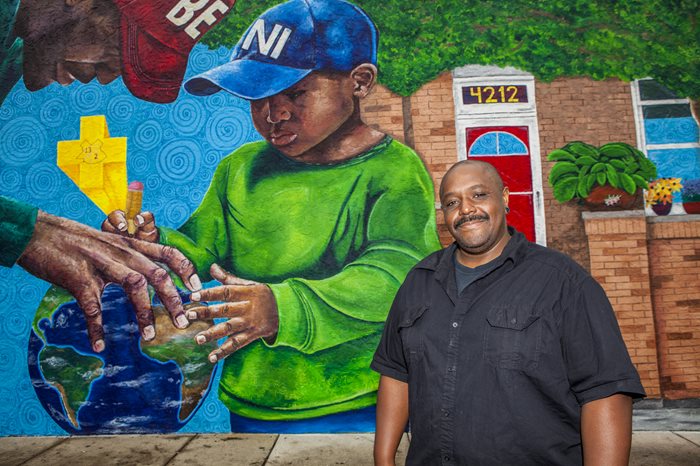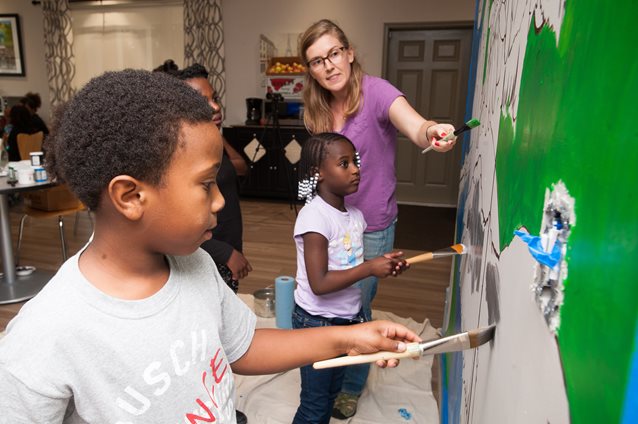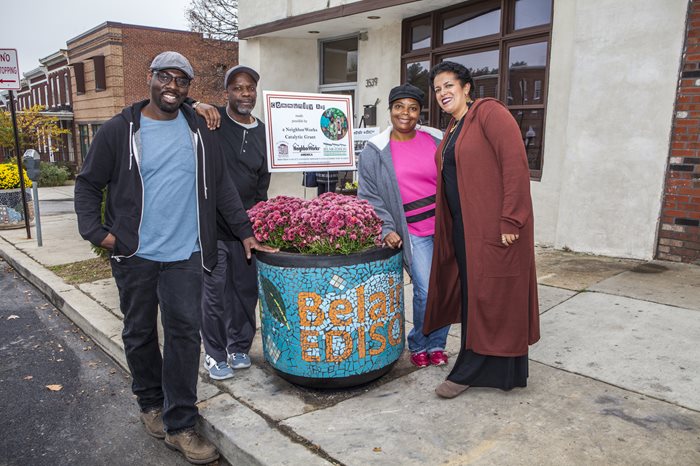 |
| Children paint a mural in Hopewell, Virginia |
Art creates community and community creates change. – Groundswell, New York City
When reviewing the work of the 11 organizations selected to receive NeighborWorks America’s Catalytic Grant, two threads are common across many of them: community building and art, in all of its many different forms.
The grant program is designed to “strengthen local capacity to plan and implement comprehensive approaches to community stabilization that produce measurable gains.” Art is cool, and often beautiful, for sure—but can it really help stabilize and revitalize a distressed community? There are many believers, and Jackie Harder, multimedia specialist with Community Housing Partners (CHP) in Hopewell, Virginia, is one of them. In fact, she focused her graduate thesis in urban planning on the subject.
“Citizens and artisans alike can bring about conscious social change using art as the platform,” she says, and shares this quote from two of the experts in the field: “It is the nature of art to create openings where one can envision something outside the realm of what already exists for oneself, one’s community and the world—a realm where anything is possible. Artists and their collaborators know that it is within this free space for creative expression that people can explore new identities and possibilities for themselves and their communities.”
However, how art is used to bring people together, re-imagine identity and/or build pride varies widely—and too often lacks strategic forethought. And that was the subject of a workshop taught at the 2015 Community Leadership Institute by Gwendolyn Kelly, a Louisville artist and graduate community education coordinator for Kentucky Educational Television—a position in which she focuses on grassroots solutions to the high school dropout crisis.
Here are some of the questions Kelly says should be answered before embarking on a community art project:
What is the primary purpose of the project?
In the best-case scenario, what will be different when the art project is complete? For example, Melanie Seawright, community building manager for Neighborhood Housing Services of the Inland Empire (San Bernardino, California) describes a mural in a “pop-up park” the organization created to beautify a particular lot. “Since it went in, there’s been no dumping,” she says. “Area residents keep an eye out for anyone who may be out to vandalize it.”In the East Side of Baltimore, St. Ambrose Housing Aid Center commissioned a mural painting to help re-brand and welcome residents to the Belair-Edison neighborhood that is the target of its Catalytic Grant spending.
 |
| Shawn James, Baltimore muralist |
However, in other cases, the primary purpose is the active engagement of residents themselves, with a professional artist as facilitator and “guide. Which leads to the next question…
Whose hands will actually do the work?
In the case of St. Ambrose, a professional mural artist from the city, Shawn James, was retained with the grant monies. James received a grant in 2003 to establish Mural Masters, which provides youth with the opportunity to develop management skills using interior and exterior mural painting as the business model. Through sponsorship of the Baltimore Office of Promotion and the Arts, the city now has more than 250 public murals.CHP, however, chose a different route, in line with its different emphasis. The organization had just rebuilt and expanded a local public housing complex, and the new development (called The Summit) included a community center. An artist herself, Harder proposed a community mural-making project.
“I wanted us to develop a product that could spark conversation and reflect residents’ experiences. My hope was that by helping paint a mural together, the residents would feel as if the space was truly theirs,” says Harder.
The process began with a design workshop facilitated by Harder in which youth residents brainstormed mural ideas around the theme of “hope,” inspired by the city’s name of Hopewell. Initially, the session produced less-than-positive references to the impoverished community, resulting in slogans such as, “There is no hope for Hopewell.”(You have to love those youth…) Determined to channel this negative energy into something productive, Harder encouraged them to visualize positive outcomes for their community.
The workshop participants then drew the images that came to mind, ranging from the bridging of two hands and symbols of happiness and love to flowers, trees and children playing. Afterward, Harder collected the images and integrated them into one design. “I incorporated their ideas and also drew on the town’s often-forgotten history. We essentially worked together to create a shared vision for the mural.”
 |
| Jackie Harder guiding her painters. |
The final step was to draw an outline of the mural on a wall in the community center, which was then painted in by young residents. According to Harder, “The process was organized as a large-scale paint-by-number exercise so that little to no skill or art experience was necessary.” After the afternoon-long collaborative painting session was completed, Harder and an assistant finished the mural to ensure a high-quality final product. In total, the mural took three days to complete.
In contrast to public art, she notes, community art demands a dual emphasis on being creative and building relationships. Whereas all art invites social interaction, in the case of community art, the process itself is social.
The challenge with “participatory art,” says Kelly, is to “inspire gatekeepers and stakeholders to trust the community-centered process, convince them to be confident about the outcomes and involve them a appropriate times for input and approval.”
What art form will you use?
Murals are often the most popular choice for public or community art. They improve the aesthetics of buildings and the neighborhood, lend themselves well to telling the story of the area, and—as Groundswell artist Danielle McDonald told Smithsonian Magazine, “The process of research for a mural and can really be transformative for the artists and the community members involved. Spaces are created that generate meaningful and necessary dialogue around real and often complicated issues that are difficult to have conversations about.”However, they have some inherent disadvantages as well—the need for an appropriate public space for instance, along with the attendant cost of upkeep and legal permissions. For example, St. Ambrose chose the exterior wall of the local Dollar Store for its mural, because of its “entryway” location. However, although the store’s owner agreed and attended the “unveiling,” he would not allow the store name to be removed, or altered to incorporate it into the design.
 |
| A team of residents from the Belair-Edison neighborhood made a mosaic planter together. |
Another popular art forms is the community quilt, which is good for long-term relationship building, Kelly’s preferred vehicle is jewelry-making. She facilitates two art-based workshops, “Bracelets & Brainstorming” and “Encouragement Banners” for youth who are at risk of dropping out of school. Kelly explains: “They’re basically conversations with students where we talk about resilience and what community can do to help them stay in school to complete their programs. While talking, we hand stamp personalized bracelets or create banners with encouraging messages. The key is, no training is needed.”
Other important questions to answer are, “When does the art have to be done?” “What are the biggest, most immediate roadblocks keeping it from being a reality?” “How much will it cost and where will you get the money?” “How will you celebrate at the end and share the work with the broader community?” “How will you know if you have achieved your goals?”
Harder sums up this way: “One universal signal of a successful projects is when your desired audience is left wishing to participate in the production of another one next year!”
Here are some additional resources related to selling others on an art project and measuring results:
A Step-by-Step Approach for Evaluating Your Arts Program's Outcome
Creative Communities and Arts-Based Placemaking
Arts and Positive Change in Communities
Making the Case for Culture: Personal and Social Development of Children and Youth

